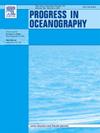Cross-shelf and along-shore transport of trace metals in shelf sediments of the East China Sea
IF 3.6
3区 地球科学
Q1 OCEANOGRAPHY
引用次数: 0
Abstract
The transport and distribution of trace metals in marine sediments are fundamental to the biogeochemical functioning of coastal and oceanic ecosystems. This study investigates the spatial distribution and transport mechanisms of trace metals (Cd, Ni, Zn, and Cr) in the sediments of the inner shelf of the East China Sea . Results show that trace metal concentrations decrease from the nearshore to the outer shelf, with higher levels observed near the Changjiang River estuary. This pattern is attributed to riverine inputs, with the metals primarily transported by terrestrial materials. The distribution of these metals is strongly correlated with fine-grained sediments, which serve as the primary carriers of trace metals, facilitating their along-shore transport by coastal currents. In addition to along-shore transport, cross-shelf transport also plays an important role in distributing these trace metals. A notable tongue-shaped anomaly in metal concentrations centered at approximately 29°N suggests that trace metals are transported across the shelf from the inner to the outer shelf and even into the deep sea. These findings highlight the complex interaction between along-shore and cross-shelf transport mechanisms in controlling trace metal distribution. Understanding these processes is crucial for evaluating the impacts of trace metal transport on marine ecosystems and their role in global biogeochemical cycles.
东海陆架沉积物中微量金属的跨陆架及沿岸迁移
海洋沉积物中微量金属的运输和分布对沿海和海洋生态系统的生物地球化学功能至关重要。本文研究了东海内陆架沉积物中微量金属Cd、Ni、Zn、Cr的空间分布及其输运机制。结果表明,从近岸到外陆架,痕量金属浓度呈下降趋势,靠近长江口处含量较高。这种模式归因于河流输入,金属主要由陆地物质输送。这些金属的分布与细粒沉积物密切相关,细粒沉积物是微量金属的主要载体,促进了它们通过海岸流沿海岸运输。除了沿岸运输外,跨大陆架运输在这些微量金属的分布中也起着重要作用。以约29°N为中心的金属浓度有一个显著的舌状异常,表明微量金属从内大陆架运输到外大陆架,甚至进入深海。这些发现强调了沿岸和跨陆架运输机制在控制痕量金属分布方面的复杂相互作用。了解这些过程对于评估微量金属运输对海洋生态系统的影响及其在全球生物地球化学循环中的作用至关重要。
本文章由计算机程序翻译,如有差异,请以英文原文为准。
求助全文
约1分钟内获得全文
求助全文
来源期刊

Progress in Oceanography
地学-海洋学
CiteScore
7.20
自引率
4.90%
发文量
138
审稿时长
3 months
期刊介绍:
Progress in Oceanography publishes the longer, more comprehensive papers that most oceanographers feel are necessary, on occasion, to do justice to their work. Contributions are generally either a review of an aspect of oceanography or a treatise on an expanding oceanographic subject. The articles cover the entire spectrum of disciplines within the science of oceanography. Occasionally volumes are devoted to collections of papers and conference proceedings of exceptional interest. Essential reading for all oceanographers.
 求助内容:
求助内容: 应助结果提醒方式:
应助结果提醒方式:


